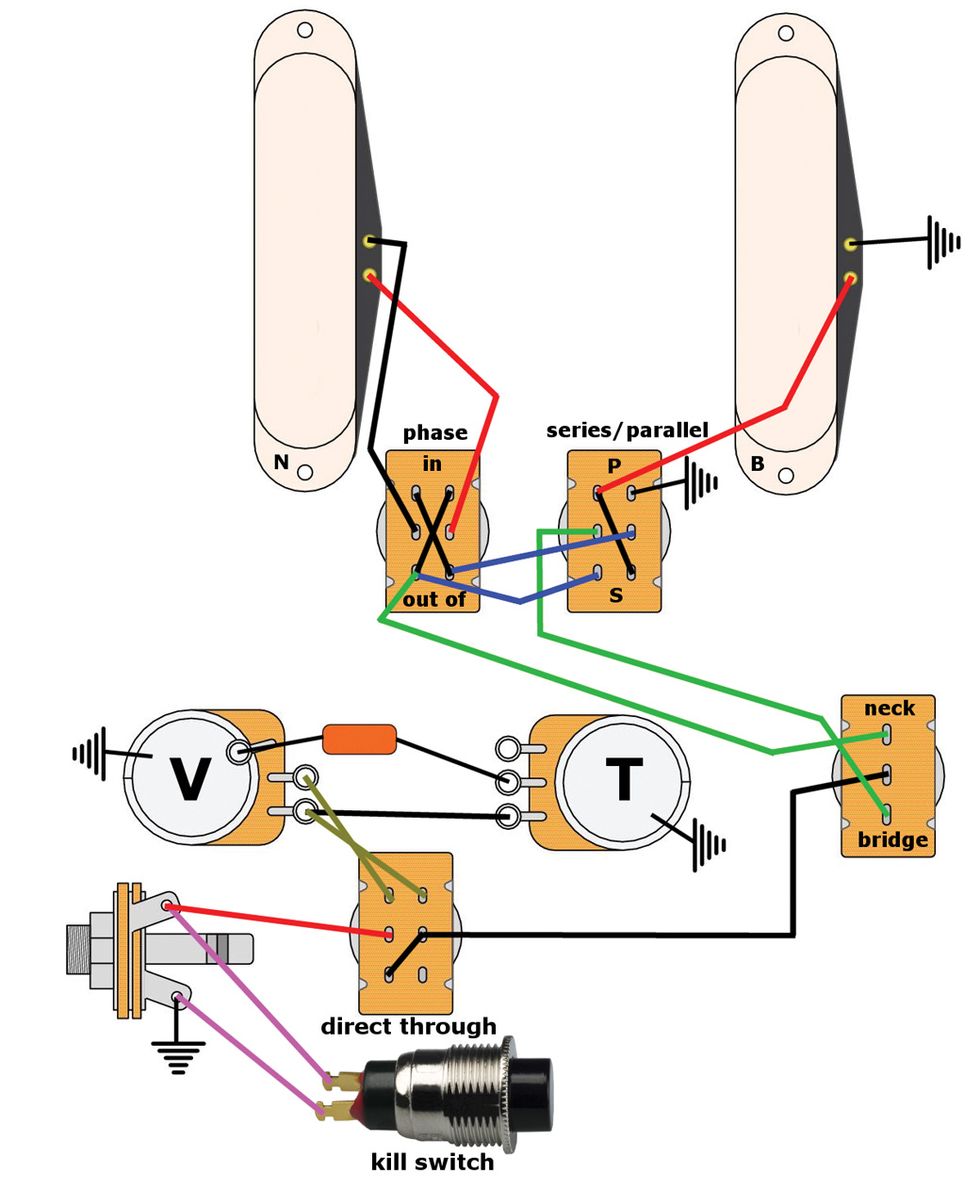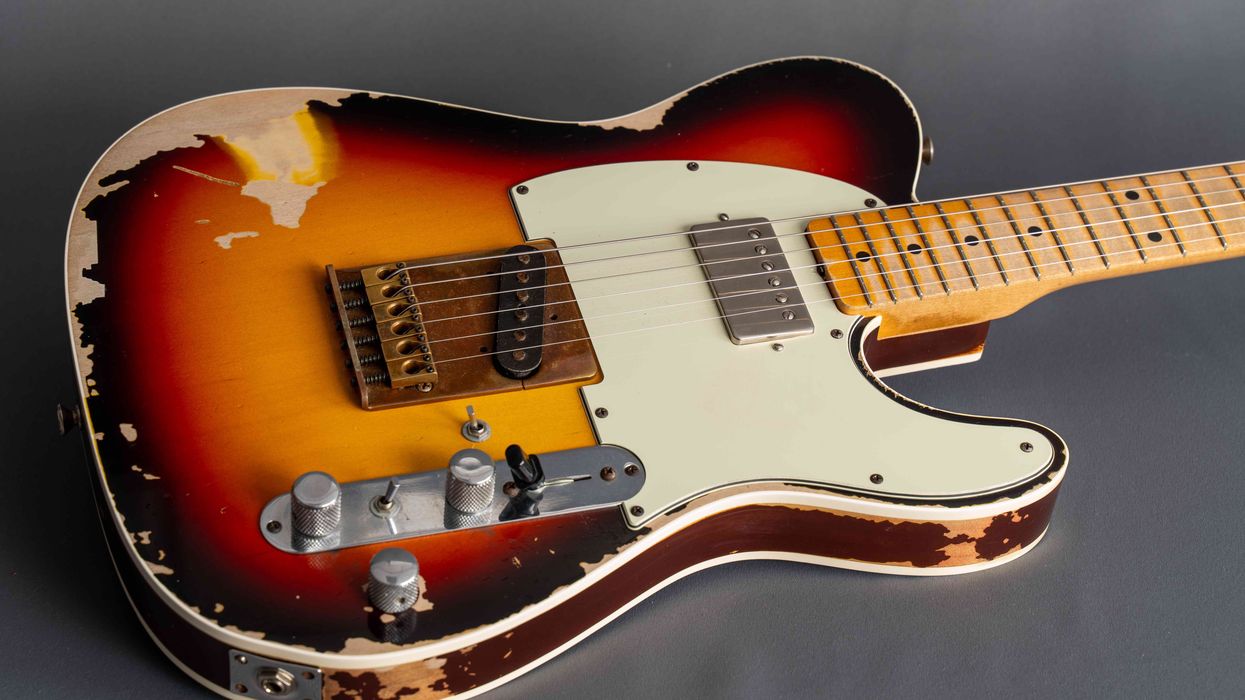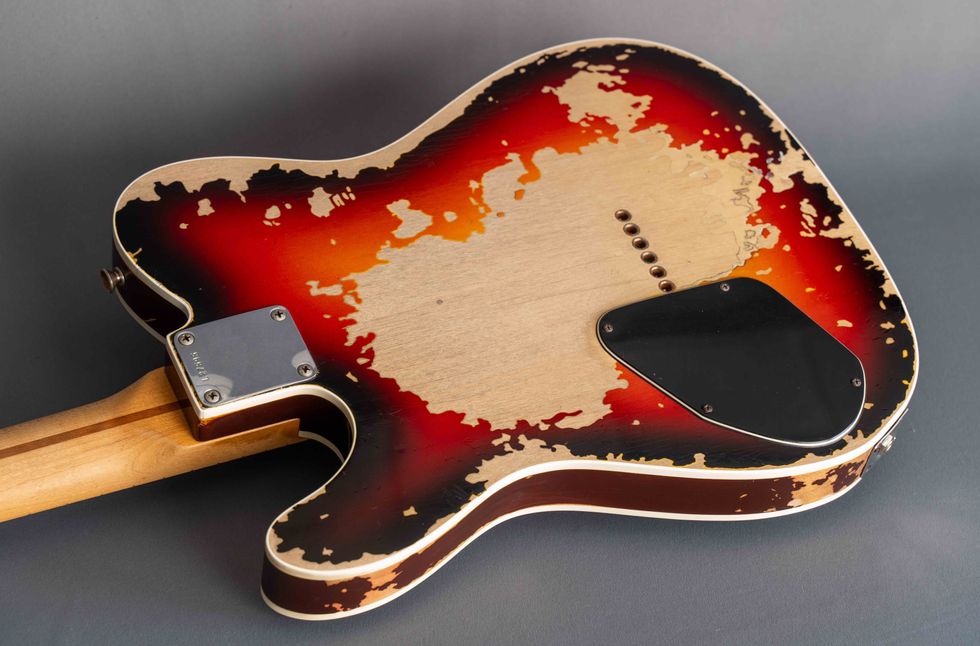Hello and welcome back to Mod Garage. This month I'll show you how to combine several mods in one guitar, making it ultra-flexible. I chose the very simple two pickups with master volume and master tone configuration because this simple layout applies to a lot of guitars and you can use this wiring for all of them. Because Fender recently added a very good Duo-Sonic model to their Player series, and I received a lot of questions about how to mod this simple guitar, I decided to show this wiring on a Duo-Sonic.
You can use this wiring for any guitar with the same layout. The Duo-Sonic uses a Gibson-style pickup selector toggle switch, but if you want to transfer the switching to a Fender-style, 3-way pickup-selector lever switch, you can use a guide made by Seymour Duncan, which you can find linked in this article online.
To start, let's make a list of what can be done with two pickups and a 3-way pickup-selector switch for an overview of the possibilities:
1. Neck pickup by itself
2. Bridge pickup by itself
3. Both pickups together in parallel and in phase
4. Both pickups together in parallel out of phase
5. Both pickups together in series and in phase
6. Both pickups together in series out of phase
This results in a proud list of six basic combinations instead of the typical three, which makes such a guitar much more flexible.
There is also another option with both pickups half out of phase in parallel and in series. We've discussed the basics of the half out-of-phase thing before, and I'm actually working on a useable design for this and will come back to this in a later column. The goal is to have a switch to toggle from half to full out of phase, because with a master volume and master tone configuration, you can't use the volume pot to dial in the amount of phasing you want on a Les Paul. For this you need a volume pot for both pickups, so a switch will be a suitable solution for a Duo-Sonic, Telecaster, etc.
More about the half out-of-phase basics can be found in two of my previous columns: “The Bill Lawrence 5-Way Telecaster Circuit" from October 2015, and “Decoding Jerry Donahue's 5-Way Telecaster Wiring" from June 2020.
Besides the possible pickup combinations, there are some add-ons we can implement to make such a guitar even more flexible. Something that I think makes sense would be:
1. Direct-through switch
2. No-load tone pot
3. Kill/standby switch
4. Treble-bleed network on the volume pot
There are many more add-ons we've discussed over the years, for example, TBX tone control, Grease Bucket tone control, etc., but it's easy to get lost in all the possibilities and overdo it. Who wants to end up with a guitar wiring that needs a written manual in order to operate it?
I've discussed all of these possibilities before, but today we'll combine them in one guitar. Here's a short rundown of what tones you can expect from these combinations:
Neck and bridge pickup by itself / both pickups together in parallel and in phase: I don't think we have to say anything about this combo as this is a classic guitar tone we all know.
Both pickups together in parallel out of phase: a thin, hollow tone that can be cool for playing reggae and ska music when using clean tones, or with tons of overdrive and distortion to prevent getting lost in the mix. For more details, have a look at “Adding an Out-of Phase Switch to a Telecaster," from August 2014.
Both pickups together in series and in phase: a loud and beefy tone, perfect for lead playing. For more details, read “Stratocaster Parallel/Series Switching" from December 2011 and “Telecaster Series Wiring" from June 2015.
Both pickups together in series out of phase: a very interesting sound that's much fuller and warmer compared to its parallel mate. Can be used for clean playing to add a special flavor but also for overdrive sounds. Brian May's “Red Special" guitar is one of the wirings that's able to give you this sound. See “Inside Brian May's Red Special" from October 2014.
Direct-through switch: Your signal is routed directly to the output jack, bypassing all controls for a louder tone with more high-end. Can be found under various names like “blower switch" and the like. See “Stratocaster Direct-Through Mod," from October 2009.
No-load tone pot: With the pot fully opened at 10, it will be out of the circuit, so it's half between normal operation and direct-though mode with only the volume control being active. See “The Fender Delta Tone System, Part 1" from January 2011 and “The Fender Delta Tone System, Pt. 2" from February 2011.
Kill/standby switch: This can be used to shut down the entire guitar when you're not playing, like during a break (standby switch, very similar to the standby switch you know from tube amps), or to produce a stutter-effect while playing (kill switch). See “The (In)famous Stratocaster Kill Switch" from December 2009 and “The (In)famous Stratocaster Kill Switch, Part II" from January 2010.
Treble-bleed network on the volume pot: preserves the high-end from getting lost when rolling down the volume. Check out “Deep Diving into Treble-Bleed Networks" from March 2019.
Fig. 1 — Image courtesy singlecoil.com
To prepare and fully understand this wiring, you should plan some time to read all the articles about the individual mods and what they do. That's the reason for so many links this time. It's simply impossible to cover all these individual mods again for one column—it would take up half the pages in this magazine!
For better clarity, I skipped the treble-bleed network in this diagram (Fig. 1). I described in detail in the treble-bleed article how to connect it between input and output of the volume pot. It's also up to you to use a no-load tone pot or not: I simply refer to it as “tone" in the drawing. For the parallel/series switch, the phasing switch, and the direct-through switch, you need a DPDT on/on switch. For the kill switch, you need to decide if you want a standby switch or a momentary kill switch, as described in the corresponding articles. Two of the switches can be substituted by push-pull or push-push pots, so your pickguard doesn't look like the main control unit from Apollo 11. There are even special kill-switch pots named “kill pot" that are available from the Shadow company. When you replace your tone pot with a push-pull or push-push pot, you'll have problems finding a no-load type if you want to keep this option. Your best bet is to mod your pot as described in the corresponding article.
As always, you can experiment with the type and value of the tone cap. Maybe you want to implement another mod here, like the warmth-control mod, which you can learn about in “Swap That Tone Knob for a Warmth Control" from November 2018.
If one of your pickups has a metal cover that's connected to the pickup's ground, like on most Telecaster neck pickups, you need to separate it to perform the series mod. I describe how to do that in “Preparing Your Tele for Future Mods" from May 2013.
For a better overview, I used individual switches for the diagram instead of push-pull pots. So, there we have it. Next month we'll return to our DIY relic'ing project and focus on the metal hardware, so stay tuned.
Until then ... keep on modding!



















![Rig Rundown: AFI [2025]](https://www.premierguitar.com/media-library/youtube.jpg?id=62064741&width=1245&height=700&quality=70&coordinates=0%2C0%2C0%2C0)

![Devon Eisenbarger [Katy Perry] Rig Rundown](https://www.premierguitar.com/media-library/youtube.jpg?id=61774583&width=1245&height=700&quality=70&coordinates=0%2C0%2C0%2C0)

















